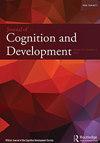Children Prefer Familiar Fantasy, but not Anthropomorphism, in Their Storybooks
IF 2.1
2区 心理学
Q3 PSYCHOLOGY, DEVELOPMENTAL
引用次数: 0
Abstract
ABSTRACT Children’s storybooks often contain fantasy elements, from dragons and wizards to anthropomorphic animals that wear clothes, talk, and behave like humans. These elements can impact children’s learning from storybooks both positively and negatively, perhaps due in part to their ability to capture children’s interest and attention. Prior research has found that children prefer realistic to make-believe stories, but little is known about children’s preferences for anthropomorphic characters. The present study examines U.S. children’s preferences for fantasy and anthropomorphism in storybooks. Seventy-two 4- to 6-year-old children (M = 65.74 months, SD = 10.84 months) were presented with 10 pairs of books (fantasy/anthropomorphic vs. realistic) and asked to select which book they liked better and why. Children chose fantasy but not anthropomorphic animal stories significantly more often than expected by chance. Children’s preferences were not related to age or gender, and they most often justified their choices with references to the storyline. Implications for creating and selecting media are discussed, since children learn best when learning materials align with their interests.孩子们更喜欢熟悉的幻想,而不是拟人化的故事书
摘要儿童故事书通常包含幻想元素,从龙和巫师到穿着衣服、说话和行为像人类的拟人化动物。这些因素会对孩子从故事书中学习产生积极和消极的影响,部分原因可能是他们能够吸引孩子的兴趣和注意力。先前的研究发现,儿童更喜欢逼真的故事,而不是虚构的故事,但对儿童对拟人化角色的偏好知之甚少。本研究调查了美国儿童对故事书中幻想和拟人化的偏好。72名4至6岁的儿童(M=65.74个月,SD=10.84个月)被出示了10对书(幻想/拟人与现实),并被要求选择他们更喜欢哪本书以及为什么。孩子们选择幻想而非拟人化的动物故事的几率明显高于预期。儿童的偏好与年龄或性别无关,他们通常会参考故事情节来证明自己的选择是合理的。讨论了创建和选择媒体的意义,因为当学习材料与他们的兴趣相一致时,孩子们学习得最好。
本文章由计算机程序翻译,如有差异,请以英文原文为准。
求助全文
约1分钟内获得全文
求助全文
来源期刊

Journal of Cognition and Development
Multiple-
CiteScore
4.00
自引率
0.00%
发文量
29
期刊介绍:
The Journal of Cognition and Development is the official journal of the Cognitive Development Society (CDS). Some CDS members are concerned with basic research or theory; others focus on policy issues and practical applications. The range of interests includes cognitive development during all stages of life, and we seek to understand ontogenetic processes in both humans and nonhumans. Finally, their interests encompass typical as well as atypical development, and we attempt to characterize both biological and cultural influences on cognitive change and continuity.
 求助内容:
求助内容: 应助结果提醒方式:
应助结果提醒方式:


